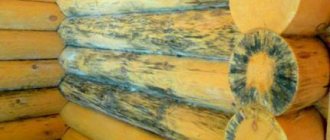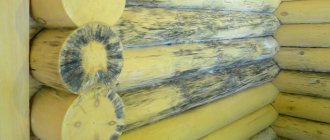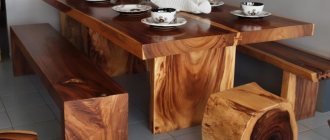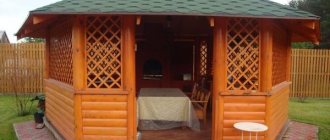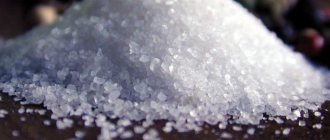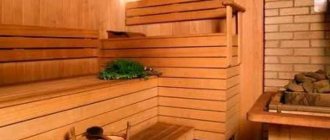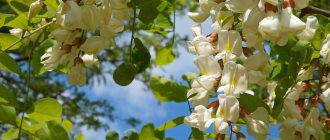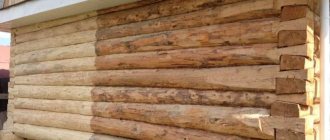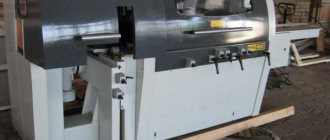Lumber and wood products are not resistant to the destructive effects of external factors. One of the negative manifestations is the blueing of wood, which makes the material unsuitable for construction and further use. If you respond to “painful” signs in a timely manner, you can get rid of blue discoloration quickly and effectively.
- Using wood with blue
- Home Remedies
- Factory means
Traditional methods of getting rid of fungus
When using what are commonly called folk remedies, you need to remember three points:
- their use is often remembered when it is too late and more effective solutions are needed;
- It is difficult to remove overgrown lesions with household solutions, and when they are destroyed there is always a risk of new colonies appearing;
- When getting rid of mold, you need to simultaneously eliminate the causes that gave rise to it.
Let's look at the available products that you can find at home or buy.
Treatment with chlorine bleaches
Stores sell a solution that is traditionally called “Whiteness”. The compositions of different manufacturers may differ, but the main substance does not change - it is sodium hypochloride, a powerful antiseptic and oxidizing agent.
At chemical plants, it is used to disinfect water and various surfaces; in everyday life, it is used to bleach fabrics and disinfect bathrooms.
Do not forget that any products containing chlorine are potentially hazardous to human health. If they enter the respiratory tract, they can cause vomiting, dizziness, and, with increased doses, poisoning, so it is necessary to use protective equipment: mask, gloves, respirator
When using the solution, it is important to determine whether it is diluted with water in a ratio of 1:10, but to combat mold a more powerful antiseptic is needed, so the proportions change to 1:1
Whiteness is ideal for smooth surfaces such as tiles or hard plastic. Wood has a porous texture, which is very difficult to process, so a chlorine solution is only suitable for removing external signs, stains and stains; it will not save you from deep penetration of fungus.
The concentrated composition is applied in several layers with a paint brush, then washed off with clean water. If the fire is in an inaccessible place (in the attic), the product does not need to be washed off.
Pharmacy antiseptic solutions
Hydrogen peroxide, which is used to treat wounds and scratches, also works great against fungus. As a rule, a small bottle of peroxide can always be found in the first aid kit, so nothing prevents you from doing a little experiment.
Moisten a cotton pad with a few drops of the solution and wipe the mold-affected wooden surface. If the stains disappear, you can process the already clean area several more times.
Like chlorine-containing substances, you don’t need to expect miracles from peroxide. You can use it to clean tiles, porcelain tiles, enameled or concrete surfaces, but wood is a soft material and cannot be quickly “treated”
If you purchased a bottle of 3% solution, do not dilute it with water, this concentration is not considered strong. It is enough to apply peroxide to the damaged area and leave for a while, then repeat the procedure.
The second solution “from the pharmacy” is ammonia, which is included in products for cleaning windows and washing the print heads of inkjet printers. It also works effectively on smooth surfaces (glass, earthenware, plastic), and with moderate success on wood (or plasterboard).
The procedure should be carried out according to the same rules as with “Belizna”: dilute in a 1:1 ratio, do not forget to wear gloves and a respirator.
The use of "kitchen" products
At least two products used to combat mold can be found in your kitchen cabinet. This is vinegar and soda.
Vinegar, like Belizna, is not able to completely remove mold, but, unlike it, it is absolutely safe for humans. It is not diluted with water, but is applied in large quantities to the infected areas using a roller, brush or sponge.
To increase efficiency, do not use weak table solutions, but vinegar essence or acid, which is more concentrated
If the mold on a wooden surface resembles plaque, then there is a chance of getting rid of it completely. However, do not forget about the persistence of harmful microorganisms and wipe the areas at risk every 2 weeks - until you correct the ventilation and insulate the room.
Soda is also one of the safest remedies. It is often used for cleaning children's clothes and washing dishes. However, when paired with vinegar, it can destroy a small colony of mold. If you notice a scattering of small black dots on the walls, dilute baking soda in vinegar and wipe the infected area.
The vinegar-soda solution can be placed in a spray bottle and sprayed on the walls (floor, ceiling, attic floors, exterior of the house) every 2-3 hours.
Soda does not harm wood, so this option is also possible: pour a small amount of powder onto a slightly dampened cloth and rub into the damaged area, and then rinse with water.
Industrial bleaches
Domestic and foreign industry today produces many effective and affordable products that can be used to whiten a log or timber house.
According to experts, one of the best bleaches is the Russian drug “Sagus”, which is used to prevent the formation of corrosion, and also effectively treats wood from fungus and whitens the surface.
Sagus not only lightens the wood, wood bleached with the product acquires an even shade, and black spots and spots disappear from it. The composition is resistant to weather conditions and humidity, so it can be used both inside and outside the house.
Another domestic product that is used to bleach wood is Neomid 500. It rids wood of fungus and mold, evens out the color, and also protects it from insects. For deep lesions, a concentrated composition is used. If there are only small pockets of fungus on the tree, the composition is diluted with water in a 1:1 ratio.
What is it and how to get rid of blue stains on wood
Blue tree - what is it?
Blue on wood
caused by a fungus. Wood is a living material that becomes an excellent medium for the reproduction and active functioning of fungi. They are what cause the color of the tree to change. “Blue” is a figurative name, since the tree, due to the fungus, can acquire various shades, both bluish and gray or even black.
Why is blue on a tree dangerous?
Blue wood
- this is not rotting; in this case, only the upper layers of the material are affected, which inevitably greatly spoils the appearance, but does not in any way affect the mechanical properties.
The danger of blue staining lies in the fact that the very presence of fungus on a tree is already an excellent breeding ground for other types of fungus, which in turn can cause rot and damage to the wood.
Factors contributing to the appearance of blue on wood:
Poor ventilation, this applies to both residential premises and warehouses where wood is stored;
High humidity. If the wood often gets wet, nothing good will come of it;
Lack of sun rays. If the wood is constantly in the shade, it will begin to become damp and eventually appear blue;
Incorrect storage of lumber. Fungal infection can occur when the material comes into contact with soil or grass.
One thing is clear - there is no need to panic, even if you discovered blue stains on a tree, it can be fixed, let's figure out how.
How to remove blue stains from wood?
How to remove blue stains from wood
is a popular question on woodworking forums.
Get rid of blue stains on wood
You can use industrial or homemade products.
Both are often based on chlorine. That’s why the process itself is called -
The most popular factory solutions are Bioshield, Neomid 500 and Belika. These are chlorine based products.
How to separate and remove blue stains from wood using them?
It is enough to treat the surface with a brush or roller; depending on the degree of damage, the treatment can be single or multiple, most often three times is enough. All of these products are highly concentrated, so when working with them you should protect your face and hands with gloves and a mask, and also take care of thorough ventilation if processing occurs indoors. When properly processed, such products provide a guarantee that they will not appear in the next twenty to thirty years.
Craftsmen often use homemade remedies to make it go away.
The most popular among them:
The easiest and cheapest way is to use ordinary household bleaches, such as whiteness;
Oxygen bleaches are also used for fabrics; they are safe and practically odorless. This bleach is produced in powder form; it must be diluted with water and applied to the surface using a spray bottle;
A solution of bleach and soda (proportions per bucket of water: 250 grams of soda and two kilograms of lime);
Caustic sodium. It is diluted with water in the proportion of 1 part sodium: 2 parts water;
The affected surface can be treated with perhydrol. This is a strong alkaline environment, after treatment it must be neutralized with a 4% acetic acid solution.
Homemade whitening products also do a good job of solving the problem, but they do not provide such long-term protection.
In addition, it is important to follow the proportions and processing procedure in order to achieve at least some result. But they cost pennies compared to industrial products
The choice is yours.
How to protect wood from blue staining?
How to remove blue stains from wood
we figured it out. Let's talk about how to protect wooden products in your home as much as possible from this nuisance.
The simplest and most far-sighted way is to treat wood with an antiseptic. Blue on wood
which is processed in this way, if it appears, it will not be very soon.
You should also pay attention to ventilation and ventilation in the room. Excessive moisture and dampness are the main factors causing blue discoloration.
Proper warehousing and storage of wood. You can’t just throw the boards in a pile and store them anywhere. It is necessary to ensure air movement between them; for this, the material is stacked. Wood should not be allowed to come into contact with the ground. To do this, they are placed on special pallets.
Before moving into a newly built house, let it sit for some time (up to a year) so that the boards dry thoroughly.
Irina Zheleznyak, Staff correspondent of the online publication “AtmWood. Wood-Industrial Bulletin"
What to paint over
Before you start painting over the blue, you need to dry the lumber and achieve a minimum level of humidity in the room. Wood will continue to deteriorate until contact with moisture is stopped and excess moisture is removed from the inner layers.
If the damage to the wood is superficial and shallow, it is enough to sand the area until the stains are eliminated.
Before applying paint, it is recommended to prime the wooden surface with a special compound containing an antiseptic. It will create a vapor-proof elastic coating, protect the wood from further destruction and give it a pleasant shade.
Manufacturers of paints and varnishes offer customers entire lines of dyes, where you can choose the appropriate shade.
For interior work, you should choose acrylate-based paints and primers. They are applied evenly, do not run down and do not have an unpleasant odor.
External painting is best done with solvent-based paints - alkyd glazes. They allow you to achieve a more durable coating and prevent wood from loosening.
It will be possible to evaluate the final shade of the acrylate film-forming coating only after the layer has completely dried.
What remedies for blue stains on wood do you consider effective?
Homemade
Factory
Disinfection
From time to time it is necessary to disinfect the cutting surface, and special attention should be paid to this process. If you are thinking about how to remove odors and food residues, weigh all the pros and cons of each method
The “thermonuclear” Soviet version is purification using chlorine. For this purpose, you need to mix five liters of water with one tablespoon of this substance. After this, a wooden board is dipped into the mixture for half an hour. You need to act very carefully, work only with gloves and do not forget about your own safety. After using chlorine on your board, you must thoroughly remove all traces of the chemical using hot water. But no one can guarantee that there are no toxic compounds left in the porous structure of the surface. Since the board is used for cooking, it is still highly undesirable to use this method.
It is better to use regular soda, available to every housewife. To do this, dilute a teaspoon in 0.5 liters of hot water and stir thoroughly. It is enough to keep the board in the solution for 5-10 minutes, then wash it thoroughly and leave it to dry in an upright position. By the way, you can clean a plastic board in the same way, since soda is a universal cleaner for many surfaces.
In addition to alkali, hydrogen peroxide is also suitable for this purpose. To do this, two teaspoons are mixed with 0.5 liters of water, after which a board is placed in the resulting composition. This method helps get rid of odors and food residues.
Traditional methods
If you don’t have any detergents at hand, you can use methods that have helped our grandmothers out more than once.
One great way to remove dirt is lemon. Just half of this citrus is enough to clean a plastic or wooden board from food debris. Rub the surface with lemon, after which the cleaned item is thoroughly washed with water.
Another folk recipe can be a combination of citrus and salt. As in the previous case, the board is rubbed with lemon and then sprinkled with salt. After 10-12 minutes, the surface is again rubbed with half a citrus fruit, and then washed with water.
If you need to remove the smell of herring or meat from the board, vinegar will do the job perfectly - you can wipe the cutting surface with it.
If you notice that the board has cracks or scratches, get rid of it as soon as possible. Even if you really like this thing, remember that if it is deeply damaged, it is no longer suitable for use.
How often do you wipe your cutting board dry after work? Not always, but in vain. This is why black spots of mold form on it. Getting rid of them is not so easy. Boards are made from a variety of materials, but wood and plastic remain the most popular. Does everyone know how to clean a cutting board? We’ll talk about this so that you don’t have any doubts about whether you’re doing everything right or missing something.
DIY ways to solve the problem
If the causes of mold are not eliminated, even after its complete destruction, spores can enter the room and return the problem. Therefore, it is necessary to carry out a number of measures to eliminate favorable conditions for the growth of fungus, especially the most common of them - high humidity.
First steps to take:
- if the attic or basement is damp, it is necessary to consider hydro- and vapor barrier, check the integrity of the roof and the condition of the foundation;
- in case of air circulation problems, adjust ventilation or design a new, more efficient system, install forced air supply devices (fans);
- if conditions permit, ensure penetration of sunlight (relevant for verandas, terraces, balconies) - mold does not tolerate ultraviolet irradiation;
- during the repair process, along with wooden cladding, it is necessary to use a vapor barrier membrane to protect against condensation;
- check the condition of surfaces bordering the contaminated area;
- thoroughly warm and dry the room where new mold colonies periodically appear - a heat gun is suitable for this.
To summarize, it is necessary to carry out any possible measures to reduce humidity.
One of the options for arranging the floor on the loggia. To prevent wooden flooring or cladding from becoming damp, it is necessary to consider ventilation ducts above the insulation layer and waterproofing (+)
Let's look at how to get rid of mold on logs or boards using chemicals.
There are a number of solutions that can be purchased at a hardware or hardware store:
- Dali
- suitable for concrete, tiles, wood, painted surfaces; - Biotol spray
- used for treating facades, cellars, attics; - Alpa
– antifungal agent for interior work; - Stop-Mold
is a concentrated composition for treating the areas most susceptible to infection - basements, terraces, attics, greenhouses.
To apply the product, it is necessary to rinse the areas with clean water, and after complete drying, apply an antiseptic solution in several layers.
You can get rid of a mold stain in a simple but labor-intensive way:
Image gallery
Construction expert Yu.N. Zelentsov answers the question.
At the stage of summer, and especially autumn construction of a wooden house, it is necessary to solve the question: how to remove blue stains from the wood of logs, timber, lumber? How to get rid of blue staining - blackening of wood? How can I remove and get rid of the fungus that causes blueing (blackening) of wood? What is the fear of blue stains that have developed on logs, beams and lumber intended for the construction of a wooden house or log house?
Our answer to these questions about blueing and blackening of wood logs (timbers) and lumber is as follows:
Our product - wood bleach - blue and black remover "League Bioshield", which is currently the Russian leader among manufacturers of bleaches and disinfectants for wood (wood), has a Russian patent, a full package of officially confirmed documents and all certificates of conformity.
Remedies for blue discoloration
To destroy blue stains and prevent its further appearance on the material, it is necessary to take a radical approach - eradicate the fungus from the deep layers of wood.
Special bleaches, impregnations and antiseptics help get rid of unsightly blue spots. They can be purchased at construction markets, or you can prepare them yourself.
Home Remedies
Chlorine. Dilute regular chlorine bleach (“Whiteness”) with water in a 1:1 ratio. Treat the entire surface area with the resulting composition, and then rinse it with plenty of water. Dry the wood thoroughly and make sure that there is no efflorescence left on it. Clean off any efflorescence that appears and then apply the finishing coat.
Important! The disadvantage of chlorine is that the substance is aggressive and can make the structure of the wood more loose
- Oxygen bleach powder.
Dilute the product in warm water until completely dissolved, place the resulting solution in a spray bottle or garden pump. Spray the liquid on the wood for an hour, without allowing the previous layer to dry. Remove stubborn mold with a stiff brush. Rinse treated areas with clean water and dry. - Bleaching powder.
Add 2 kg of bleach and 250 g of soda to a bucket of water. Mix the mixture and let it sit. Drain the water and treat the wood with the resulting slurry using a brush or roller.
Factory means
"Bioshield"
- a wood bleach with antiseptic properties. Effectively removes fungi that cause blue and blackening of the surface, destroys fungal spores and putrid blackness. Suitable for processing all types of lumber. If the lesions have spread deep into the wood, the product is used as an impregnation - applied to the surface several times with an interval of 1-2 hours.
"Neomid 500"
— concentrated bleach with a regenerating effect. Quickly copes with fungi that cause significant changes in the color of wood. Returns the tree an attractive appearance without changing its characteristics and properties. Can be used in its original or diluted form.
"Prosept 50"
— fast-acting chlorine bleach for wood. The result of the drug will be noticeable within 30 minutes after treatment. The active substance penetrates into the deep layers of lumber without changing its natural properties. The product contains no dangerous additives, which allows it to be used even for impregnating wooden surfaces that come into contact with food.
The fight against blue stains on wood should begin at the logging stage. Proper storage and transportation of the material will help protect it from fungus and preserve its beneficial properties. If mold does appear, it should be destroyed as soon as possible, using proven means.
The most popular material that is used when construction is started or, despite technological progress and the latest developments, is still wood. This is due both to its technical characteristics and to the fact that the cost of renovating an apartment in Moscow can be significantly lower if wood is used rather than, for example, metal elements. Alas, wood is susceptible to various damages and quickly becomes covered with dark gray spots and blue stains. In damp air and high temperatures, flying fungal spores quickly do their job. What to do? Do I need to get rid of the affected material or can it be saved? Let's try to figure it out.
Why is it dangerous?
Fungal infections penetrate the wood to a relatively small depth - up to 2 mm. At the first stages, the strength of lumber does not change. It can be used for construction or repair work. But the mold-affected area will absorb more moisture, which means the processes of fiber destruction will occur more and more intensely.
What are the risks of using wood with blue stains?
- the erected structure becomes unstable and loses strength;
- products made from such wood can deform in a short time;
- the aesthetic appearance and presentability of the tree is lost, an unpleasant musty smell appears;
- a residential building made from affected lumber becomes hazardous to health - mold provokes joint pain, allergic reactions, and lung diseases.
Important! There is a so-called internal blue stain, when the outer layer of raw wood is dried, and a fungal infection has already appeared in the inner layers.
Whitening products
Bleaching of logs is carried out using special bleaching agents, which are divided into two large groups:
- Chlorine-containing products. These include products containing: sodium or potassium hypochlorite, bleach, chlorine dioxide.
- Compositions without chlorine, in which the active substances are ammonia, hydrogen peroxide, oxalic acid and alkalis.
Any composition for bleaching wood operates on the same principle: it causes an oxidative process, as a result of which the coloring pigment becomes discolored and the fungal molecules are destroyed.
Before treating wood with bleaching agents, the surface must be sanded well. As a result of sanding, up to 20% of the blue stain is removed. In addition, bleach penetrates and is absorbed into the wood structure better if it is applied to sanded boards.
So, the main recommendations:
- after bleaching, any composition must be washed off with water;
- acid-based bleach is washed off with an aqueous solution of soda;
- You cannot combine different compositions; the surface can only be treated with one product.
- if the wood is severely affected by fungus, it is necessary to treat it with a more concentrated composition.
- bleaching is most effective if it is carried out at a temperature of 18-20 degrees Celsius and at a humidity of about 60%;
- When processing wood inside the house, it is necessary to ensure ventilation of the room, because Almost all formulations contain components that are unsafe for health. If the treatment was carried out in a bathhouse, it is necessary to dry-heat the room twice before taking bath procedures to remove chlorine fumes.
Below you will learn how to whiten a log house after sanding.
How to Contact a Mold Remediation Specialist
- You call or leave a request on the website.
- A specialist comes to the site and determines the scale of the problem and chooses a method for eliminating it.
- A team is formed to remove the vice.
- The work itself is performed (processing and mechanical cleaning of contaminated surfaces).
- Treatment is carried out with special means.
- Our employees will help you understand the reasons for the appearance of blue discoloration, and also give recommendations for carrying out preventive work.
To protect yourself from the effects of harmful fungi, you need to seek help from mold control specialists.
Causes and consequences of blue wood
Most often, fungal infections occur due to violations of storage and operating conditions. The main factors for the appearance of blue discoloration:
- imperfect ventilation in warehouses or residential premises - wood is “healthier” where air flows circulate better;
- excess moisture - the tree should be stored without access to moisture, as it easily absorbs it; if the moisture content of the material reaches 18%, the fungal spores will be very happy, this is an excellent environment for their development;
- lack of sun - if a tree is constantly in a shaded area, it inevitably begins to become damp;
- the same will happen with prolonged contact of building materials with soil or grass;
- poor-quality processing of logs, boards, beams - if the surface is not processed for complete smoothness and there are knots, cracks, roughness, bark residues on it, it is more vulnerable to fungal infection.
It happens that a tree is affected while still standing - if weevils, bark beetles and other wood destroyers have had time to dine on it. They violate the integrity of the surface, and blue discoloration develops in the affected areas.
Types of antiseptics to protect the surface of timber
Today you can purchase two types of antiseptic mixtures:
1. Water-repellent. Such products are characterized by the ability to penetrate deeply into wood, thereby increasing the service life of the material. A feature of water-repellent antiseptic mixtures is that they can only be applied to dry timber.
2. Water soluble. This type of antiseptic can be used even if the surface of the wood is wet. They cover the top layer of the timber without penetrating into the deeper layers. At the same time, water-soluble antiseptics are safe for health, which is an important advantage.
Rules of care
Typically, all care requirements can be read on the label that accompanies any product. It indicates whether the item can be washed or should only be dry washed. If you can wash it, it will say at what temperature it is best to do it.
Can the item you purchased be ironed, or is it better to simply dry it on a horizontal surface, having first smoothed out all the wrinkles and irregularities?
If your items can be ironed, then pay attention to your own iron. It should make it possible to adjust heating modes, depending on the fabric from which your clothes are made
It should allow you to adjust the heating modes, depending on the fabric from which your clothes are made.
When you are ready to wash, check the clothes for stains. If stains are found, they should first be washed separately and only then washed as a whole. It is imperative to sort things depending on color (or according to the principle of whether they shed or not).
All zippers and buttons must be fastened. Delicate, delicate items are best washed in bags and for them you should not set the spin mode to too high a speed.
You should air dry your clothes, but try to keep things out of the sun in summer, this will protect them from fading. It is better to dry woolen items horizontally to avoid them being pulled out; under no circumstances should you use a radiator to dry woolen items.
Removing odors from plastic boards
Plastic products absorb unpleasant odors less, but over time they also require serious manipulation. There are several ways to clean a plastic cutting board.
Method No. 1. For the first method you will need water (5 l.) and any bleach (5 tbsp.). Mix the components and place the board in the solution for 15 minutes. After the specified time, remove the product and rinse thoroughly.
Method No. 2. Mix soda and citric acid in a container, dilute the substances with water to a paste, and apply the resulting paste to the surface of the board. After 30 minutes, remove the mixture with hot water or soap solution.
Method No. 3. This method is not aimed at eliminating odors, but at removing stains, for example, from carrots. You need to take vegetable oil, a cotton swab and wipe off all unwanted dirt from the surface. After the procedure, wash the board with dishwashing detergent in the usual way.
This is not always convenient, but in this way you can preserve not only the integrity of the product, but also your health.
If damage and cracks appear on the boards, then you should not cut food on it, as pathogenic bacteria can multiply in these scratches. Do not neglect this advice, because there is a high risk of contracting E. coli or salmonella.
It’s a fact that you need to clean your cutting board. And it’s not even a matter of mixing smells and tastes, but the danger that lies behind the use of old, poorly washed boards.
Glass, granite and stainless steel
Cutting boards made from glass and other non-porous materials are safe and easy to handle. Simply wash them with hot water and soap and wipe dry each time after use.
Natural stone does not tolerate the effects of alkali and acids. Glass, on the contrary, is resistant to almost any active substance, so such boards are perfectly resistant to washing in the dishwasher.
Plastic
There is an opinion that plastic cutting boards are easier to care for than wooden ones. This is not entirely true. Indeed, the new non-porous plastic is not afraid of water and any detergents, except concentrated acids. But, unfortunately, this material quickly becomes unusable. The knife leaves scratches on the plastic in which small particles of food get stuck - they cannot be cleaned either by hand or in the dishwasher.
Wash plastic boards thoroughly with hot water and detergent each time after use. Disinfect the board on which you cut meat or fish with a solution of vinegar, baking soda or citric acid, having previously cleaned the surface of dirt. If you notice the first signs of damage to the plastic, replace the board with a new one.
Tree
Natural wood cutting boards are considered the most hygienic (according to a 1995 study by Dr. Dean Cliver). Although wood products cannot be washed in the dishwasher, there are other ways to effectively clean the surface.
Dr. Klyver's study states: "Although the bacteria that disappeared from the surface were still found in the deeper layers of the wood some time after the cutting board was used, they are not active, do not reproduce, and soon die."
How to clean a wooden board:
Remove any remaining food from the surface using a stiff brush or wire mesh.
Wash the board with soapy water.
Rinse it under running water.
Optional: disinfect the surface with a solution of table vinegar.
Pat the board dry with paper towels and then air dry it thoroughly before next use. Excess moisture can cause wood to crack.
Once a month, lubricate wooden boards with food-grade mineral oil.
Overview of the antiseptic products market
When folk remedies are useless, heavy artillery enters the battle - highly effective chemical solutions that are used both for prevention (initial treatment) and for “treating” already damaged elements. Let's look at the popular antiseptics that can be found on the shelves of construction supermarkets.
Most of the products presented by modern manufacturers are universal. Their composition is such that it simultaneously protects the wood from rot, mold, sunlight, bugs and even fire.
Wood for the external cladding of a house, like all elements of decorative interior design, must be processed without fail, otherwise the risk of damage is very high.
Tikkurila Valti - has excellent protective properties even in difficult atmospheric conditions, contains natural oils, and prevents the formation of mold. Volume 2.7 l – 1500 rub.
Let’s name several manufacturers of antiseptics that are popular and regularly occupy the top lines of the ratings:
Tikkurila. Known for a large range of multi-component impregnations that can protect wood in the most difficult conditions. Pay attention to Valtti Pohjuste deep penetration primer, Vinha covering solution. Tinted impregnation-glaze Valtti Color (Extra, Satin, Primer series) penetrates deep into wood fibers and does not form a film, as a result of which wooden products look natural.
Senezh. The most reliable antiseptic is for deep impregnation, ideal for treating facades. It is not washed out with water and is able to protect wood in difficult weather conditions. Senezh Ecobio is designed for use inside the home, and Aquadecor was created specifically for decoration. There are many positive reviews about Senezh protective equipment for saunas and baths.
Belinka. Suitable for processing internal and external wooden surfaces. BELINKA BASE contains a concentrated portion of biocides, BELOCID is suitable for both prevention and treatment of contaminated surfaces
BELINKA IMPREGNANT is a colorless impregnation, good where it is important to preserve the natural texture of the fibers.
Aquatex. Perfectly protects logs, boards, lining, chipboards from mold and wood-boring beetles. Has more than 10 tinted options
The solution is used as a primer or impregnation.
Neomid. A well-known Russian brand with a wide range of antiseptic products. NEOMID 440 ECO effectively protects wood products in rooms with high humidity, NEOMID 400 is used for processing interior parts, NEOMID 46 BiO protects lumber from mold damage.
The list can be continued with the names of alternative products: Dufa Wood Protect, Sitex, Pinotex, Texturol, Woodmaster. When using this or that product, you must act strictly according to the instructions.
Building structures treated with the products are not at risk of premature destruction. Its use guarantees the preservation of load-bearing capacity
In addition to protecting against mold, Minwax Cleaner restores the color and structure of wood used in the construction of furniture.
Antifungal treatment of building materials and structures that come into contact with a humid environment and suffer from atmospheric conditions will eliminate the destructive consequences for wood
The antiseptic formula is designed to combat mold on wood, the composition is absolutely safe for humans and four-legged pets
Preventing food contamination
Who wants to suffer from food poisoning? Follow these simple tips to avoid such problems:
Buy hard acrylic or rubber boards as they are the most hygienic to use (these are the boards commonly used in restaurants). Wooden boards should be disinfected regularly and kept as clean as possible. It is convenient to have several boards for different types of food. You should have at least two of them: one for raw meat and fish, the other for vegetables, bread and any other foods that can be eaten raw. Buy colored sets of cutting boards or label the boards yourself, this will make it much easier to distinguish them by purpose. Throw away any cutting boards that have cracks, large scratches, or obvious signs of dirt.
Like all kitchen utensils, cutting boards have an expiration date and it is important to dispose of them promptly to maintain kitchen hygiene and cleanliness.
Processing cutting boards
Most wooden cutting boards are made from hardwoods such as teak, although bamboo cutting boards are also quite common. Any type of wood should be treated to prevent stains and keep food odors and bacteria from lingering on the surface.
Use an oil that can be used repeatedly, such as food-grade mineral oil.
It is safe and will fill the pores of the wood well. Another name is liquid paraffin, edible petroleum jelly. Rub the oil onto the board and let it soak into the wood. Wipe off excess oil with a clean, dry cloth. Repeat this process at least once a month.
Attention! Do not use vegetable oil on cutting boards. This oil will go rancid and cause an unpleasant odor.
After mineral oil, apply beeswax
, it will make the surface of the board waterproof, which will protect the wood from wear and tear and extend its service life. In a microwave-safe container, microwave 1/2 teaspoon (2.5 ml) beeswax with 1 cup (240 ml) mineral oil for about 45 seconds. Apply warm wax to cutting board. Based on materials from www.cleanipedia.com, ru.wikihow.com
Wooden kitchen cutting boards have many advantages compared to their plastic and ceramic counterparts. Products do not slip on their surface, allowing you to cut them much more confidently and quickly. In addition, dense wood, in addition to its environmental friendliness, is also famous for its durability, so wooden boards last much longer than their other analogues.
But wooden cutting boards have their drawbacks. The main ones are the ability of wood to absorb odors and change its appearance for the worse. In order for the board to last longer, it is necessary to properly care for it. I hope now you know how to do it :o)….
Over time, kitchen boards absorb odors, and this problem can no longer be solved by simply washing. It’s not very pleasant to cook on such a household item, but you shouldn’t throw it away right away, since cutting boards in the kitchen can be cleaned effectively and in a short time.
If you liked the article, please share it
Previously on the topic:
Share
